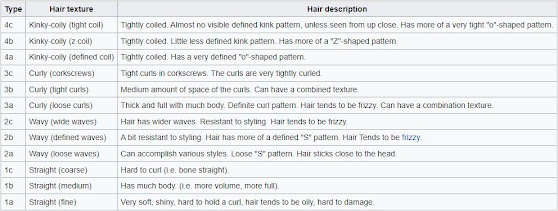Ulotrichous (pronounced Ulotri-c-hous)
Having crisp, woolly or curly hair.
1827: From the New Latin ulotrich(ī) (curly hair)
from the Ancient Greek οὖλος (oulos) (curly) + the root τριχ (trikh) of θρίξ (thríx) (hair) + -ous.
The -ous suffix was from the Middle English -ous, from Old French -ous
& -eux, from the Latin -ōsus (full, full of) and a doublet of -ose in unstressed position; it was used
to form adjectives from nouns, to denote possession or presence of a quality in
any degree, commonly in abundance
Leiotrichous
(pronounced leiotri-c-hous)
Having smooth (straight) hair.
1827: From the New Latin leiotrich(i) (smooth hair) from the Ancient Greek λεῖος (leîos)
(smooth) + the root τριχ (trikh) of
θρίξ (thríx) (hair) + -ous. The -ous suffix was from the Middle English -ous, from Old French -ous & -eux, from the Latin -ōsus
(full, full of) and a doublet of -ose
in unstressed position; it was used to form adjectives from nouns, to denote
possession or presence of a quality in any degree, commonly in abundance
Cymotrichous
(pronounced cy·motri·c·hous)
Having hair somewhere between curly and smooth; includes the wavy spectrum.
1827: From the New Latin cymotrich(i) (wavy hair)
from the Ancient Greek κῦμα
(kûma) (wave) + the
root τριχ (trikh) of θρίξ (thríx) (hair) + -ous. The -ous suffix was from the Middle English -ous, from Old French -ous & -eux, from the Latin -ōsus
(full, full of) and a doublet of -ose
in unstressed position; it was used to form adjectives from nouns, to denote
possession or presence of a quality in any degree, commonly in abundance
Lindsay Lohan: Ulotrichous.
That these three words exist is due to the French military officer, naturalist and politician Jean-Baptiste Bory de Saint-Vincent (1778-1846). A biologist and geographer, his early academic interests lay in volcanology and botany and in the early nineteenth century he travelled extensively in Europe, Africa and the Caribbean studying plants, the need to document and classify his findings meaning he became expert in systematics and this skill he adapted to the classification of people into races. For a number of reasons, his 1825 volume Essai zoologique sur le genre humain (Zoological essay on the human race) is now just a footnote in the discipline but was for decades influential. The book was an attempt to classify humans with straight hair into the Leiotrichi and those with woolly or tufted hair into the Ulotrichi, with many sub-groups below these headings, a third category, the Cymotrichi, later added, apparently to accommodate those inconsiderate to have hair not quite straight yet not sufficiently curly to be properly ulotrichous.
Lindsay Lohan: Leiotrichous.
The terms he used to
describe the method of racial classification for the purpose of human taxonomy
added to existing systems of classifications, Bory (the shorthand in the
literature which references his work) in his 1825 book adding leiotrichi, japeticus, arabicus, indicus,
scythicus, sinicus, hyperboreus, neptunianus, australasicus, columbicus,
americanus, patagonicus, oulotrichi, aethiopicus, cafer, hottentotus & melaninus. His classification was a technically
competent exercise in systematics and was thought a scientifically orthodox
document, seriously studied for most of the nineteenth century and quoted by
many noted figures including TH Huxley (1825–1895) and Charles Darwin
(1809–1882) and his classifications remain used by many specialists in zoology
and even botanists for their vivid, illustrative value. The politics of language does however intrude
on the zoologists and some, especially in the United States, prefer
lissotrichous (smooth-haired from the Greek lissos) because of the history
attached to Bory.
Lindsay Lohan: Cymotrichous.
What later became controversial
was the adoption of the scheme, especially the word ulotrichous (having crisp,
woolly or curly hair) by nineteenth century anthropologists to create a division
of humankind encompassing those with crisp, woolly or curly hair. Because of the racial association, the words
are no longer in general use in human classification although the system still
has a role in the technical language of pathology and forensic medicine. Other than those specialized fields, while
not extinct, they’re rare and for most, it’s no loss, smooth, surly and wavy
being adequate for all except hairdressers who, needing precision, have a
classification of hair in a dozen categories (1A to 4C).




No comments:
Post a Comment